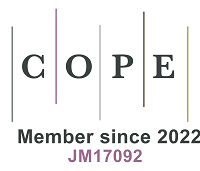REFERENCES
1. Cole M, Lindeque P, Halsband C, Galloway TS. Microplastics as contaminants in the marine environment: a review. Mar Pollut Bull 2011;62:2588-97.
2. Hale RC, Seeley ME, La Guardia MJ, Mai L, Zeng EY. A global perspective on microplastics. JGR Oceans 2020;125:e2018JC014719.
3. Stubbins A, Law KL, Muñoz SE, Bianchi TS, Zhu L. Plastics in the earth system. Science 2021;373:51-5.
4. MacLeod M, Arp HPH, Tekman MB, Jahnke A. The global threat from plastic pollution. Science 2021;373:61-5.
5. National Geographic. The world’s plastic pollution crisis explained. Available from: https://www.nationalgeographic.com/environment/article/plastic-pollution. [Last accessed on 23 May 2024].
7. Kumar M, Chen H, Sarsaiya S, et al. Current research trends on micro- and nano-plastics as an emerging threat to global environment: a review. J Hazard Mater 2021;409:124967.
8. Gigault J, Halle AT, Baudrimont M, et al. Current opinion: what is a nanoplastic? Environ Pollut 2018;235:1030-4.
9. Lechthaler S, Waldschläger K, Stauch G, Schüttrumpf H. The way of macroplastic through the environment. Environments 2020;7:73.
10. Peng J, Wang J, Cai L. Current understanding of microplastics in the environment: Occurrence, fate, risks, and what we should do. Integr Environ Assess Manag 2017;13:476-82.
11. Miller ME, Hamann M, Kroon FJ. Bioaccumulation and biomagnification of microplastics in marine organisms: a review and meta-analysis of current data. PLoS One 2020;15:e0240792.
12. Egbeocha C, Malek S, Emenike C, Milow P. Feasting on microplastics: ingestion by and effects on marine organisms. Aquat Biol 2018;27:93-106.
13. Fossi MC, Coppola D, Baini M, et al. Large filter feeding marine organisms as indicators of microplastic in the pelagic environment: the case studies of the Mediterranean basking shark (Cetorhinus maximus) and fin whale (Balaenoptera physalus). Mar Environ Res 2014;100:17-24.
14. Zantis LJ, Bosker T, Lawler F, et al. Assessing microplastic exposure of large marine filter-feeders. Sci Total Environ 2022;818:151815.
15. Bessa F, Ratcliffe N, Otero V, et al. Microplastics in gentoo penguins from the Antarctic region. Sci Rep 2019;9:14191.
16. Kuhn S, Bravo Rebolledo EL, van Franeker JA. Deleterious effects of litter on marine life. In: Bergmann M, Gutow L, Klages M, editors. Marine anthropogenic litter. Cham: Springer; 2015. pp. 75-116.
17. Monteiro LR, Costa V, Furness RW, Santos RS. Mercury concentrations in prey fish indicate enhanced bioaccumulation in mesopelagic environments. Mar Ecol Prog Ser 1996;141:21-5.
18. Morel FMM, Kraepiel AML, Amyot M. The chemical cycle and bioaccumulation of mercury. Annu Rev Ecol Syst 1998;29:543-66.
19. Chopra AK, Sharma MK, Chamoli S. Bioaccumulation of organochlorine pesticides in aquatic system--an overview. Environ Monit Assess 2011;173:905-16.
20. Sheehan KL, Lawson P, Emerson B. Fate of plastics in cattle digestive systems. J Agric Saf Health 2022;28:205-14.
21. Ma H, Pu S, Liu S, Bai Y, Mandal S, Xing B. Microplastics in aquatic environments: toxicity to trigger ecological consequences. Environ Pollut 2020;261:114089.
22. Solleiro-Villavicencio H, Gomez-De León CT, Del Río-Araiza VH, Morales-Montor J. The detrimental effect of microplastics on critical periods of development in the neuroendocrine system. Birth Defects Res 2020;112:1326-40.
23. Kidd KA, Hesslein RH, Ross BJ, Koczanski K, Stephens GR, Muir DCG. Bioaccumulation of organochlorines through a remote freshwater food web in the Canadian Arctic. Environ Pollut 1998;102:91-103.
24. Borgå K, Gabrielsen GW, Skaare JU. Biomagnification of organochlorines along a Barents Sea food chain. Environ Pollut 2001;113:187-98.
25. McIntyre JK, Beauchamp DA. Age and trophic position dominate bioaccumulation of mercury and organochlorines in the food web of Lake Washington. Sci Total Environ 2007;372:571-84.
26. Kyriakopoulos GL, Zamparas MG, Kapsalis VC. Investigating the human impacts and the environmental consequences of microplastics disposal into water resources. Sustainability 2022;14:828.
27. Jovanović B. Ingestion of microplastics by fish and its potential consequences from a physical perspective. Integr Environ Assess Manag 2017;13:510-5.
28. Wright SL, Thompson RC, Galloway TS. The physical impacts of microplastics on marine organisms: a review. Environ Pollut 2013;178:483-92.
29. Nava V, Leoni B. A critical review of interactions between microplastics, microalgae and aquatic ecosystem function. Water Res 2021;188:116476.
30. Schnurr PJ, Allen DG. Factors affecting algae biofilm growth and lipid production: a review. Renewable and Sustainable Energy Reviews 2015;52:418-29.
31. Wang J, Guo X, Xue J. Biofilm-developed microplastics as vectors of pollutants in aquatic environments. Environ Sci Technol 2021;55:12780-90.
32. Zhang C, Chen X, Wang J, Tan L. Toxic effects of microplastic on marine microalgae Skeletonema costatum: interactions between microplastic and algae. Environ Pollut 2017;220:1282-8.
33. Savoca MS, Wohlfeil ME, Ebeler SE, Nevitt GA. Marine plastic debris emits a keystone infochemical for olfactory foraging seabirds. Sci Adv 2016;2:e1600395.
34. Procter J, Hopkins FE, Fileman ES, Lindeque PK. Smells good enough to eat: Dimethyl sulfide (DMS) enhances copepod ingestion of microplastics. Mar Pollut Bull 2019;138:1-6.
35. Turner JT. The importance of small planktonic copepods and their roles in pelagic marine food webs. Zool Stud 2004;43:255-66. Available from: https://zoolstud.sinica.edu.tw/Journals/43.2/255.pdf. [Last accessed on 7 Aug 2024]
36. Støttrup JG. The elusive copepods: their production and suitability in marine aquaculture: copepods in marine aquaculture J G Støttrup. Aquac Res 2000;31:703-11.
37. Ajiboye OO, Yakubu AF, Adams TE, Olaji ED, Nwogu NA. A review of the use of copepods in marine fish larviculture. Rev Fish Biol Fisheries 2011;21:225-46.
38. Cole M, Lindeque P, Fileman E, et al. Microplastic ingestion by zooplankton. Environ Sci Technol 2013;47:6646-55.
39. Cole M, Lindeque P, Fileman E, Halsband C, Galloway TS. The impact of polystyrene microplastics on feeding, function and fecundity in the marine copepod Calanus helgolandicus. Environ Sci Technol 2015;49:1130-7.
40. Cole M, Coppock R, Lindeque PK, et al. Effects of nylon microplastic on feeding, lipid accumulation, and moulting in a coldwater copepod. Environ Sci Technol 2019;53:7075-82.
41. Avery-Gomm S, O’Hara PD, Kleine L, Bowes V, Wilson LK, Barry KL. Northern fulmars as biological monitors of trends of plastic pollution in the eastern North Pacific. Mar Pollut Bull 2012;64:1776-81.
42. Costa E, Piazza V, Lavorano S, Faimali M, Garaventa F, Gambardella C. Trophic transfer of microplastics from copepods to jellyfish in the marine environment. Front Environ Sci 2020;8:571732.
43. Setälä O, Fleming-Lehtinen V, Lehtiniemi M. Ingestion and transfer of microplastics in the planktonic food web. Environ Pollut 2014;185:77-83.
44. Hansson L, Gyllström M, Ståhl-delbanco A, Svensson M. Responses to fish predation and nutrients by plankton at different levels of taxonomic resolution. Freshw Biol 2004;49:1538-50.
45. Rasdi NW, Qin JG. Improvement of copepod nutritional quality as live food for aquaculture: a review. Aquac Res 2016;47:1-20.
46. Manning CG, Foster SJ, Vincent ACJ. A review of the diets and feeding behaviours of a family of biologically diverse marine fishes (Family Syngnathidae). Rev Fish Biol Fisheries 2019;29:197-221.
47. Smith M, Love DC, Rochman CM, Neff RA. Microplastics in seafood and the implications for human health. Curr Environ Health Rep 2018;5:375-86.
48. Neves D, Sobral P, Ferreira JL, Pereira T. Ingestion of microplastics by commercial fish off the Portuguese coast. Mar Pollut Bull 2015;101:119-26.
49. Cox KD, Covernton GA, Davies HL, Dower JF, Juanes F, Dudas SE. Human consumption of microplastics. Environ Sci Technol 2019;53:7068-74.
50. Pironti C, Ricciardi M, Motta O, Miele Y, Proto A, Montano L. Microplastics in the environment: intake through the food web, human exposure and toxicological effects. Toxics 2021;9:224.
51. Yee MS, Hii LW, Looi CK, et al. Impact of microplastics and nanoplastics on human health. Nanomaterials 2021;11:496.
52. Hamid F, Bhatti MS, Anuar N, Anuar N, Mohan P, Periathamby A. Worldwide distribution and abundance of microplastic: how dire is the situation? Waste Manag Res 2018;36:873-97.
53. Cospheric. Technical information sheet: suspension of hydrophobic particles in aqueous solution. 2017. Available from: https://www.cospheric.com/images/PDFs/Suspension-of-Hydrophobic-Particles-in-Aqueous-Solution-1.pdf. [Last accessed on 23 May 2024].
54. Rinawati M, Sari LA, Pursetyo KT. Chlorophyll and carotenoids analysis spectrophotometer using method on microalgae. IOP Conf Ser Earth Environ Sci 2020;441:012056.
55. Lichtenthaler HK, Buschmann C. Chlorophylls and carotenoids: measurement and characterization by UV-VIS spectroscopy. Curr Protoc Food Anal Chem 2001;1:F4.3.1-8.
58. Tave D, Toya LA, Hutson AM. Behavioral observations of the endangered Rio Grande silvery minnow in a conservation aquaculture facility. Croat J Fish 2018;76:7-26.
59. Pich JM, Belden A, Carlson BE. Individual variation in boldness in turtles is consistent across assay conditions and behavioural measures. Behav 2019;156:1039-56.
60. Hammond TT, Jacobs LE, Curtis MJ, Trotman EM, Swaisgood RR, Shier DM. Early life experience with predators impacts development, behavior, and post-translocation outcomes in an endangered amphibian. Anim Conserv 2023;27:23-36.
62. Ross RM, Krise WF, Redell LA, Bennett RM. Effects of dissolved carbon dioxide on the physiology and behavior of fish in artificial streams. Environ Toxicol 2001;16:84-95.
63. Tosetto L, Williamson JE, Brown C. Trophic transfer of microplastics does not affect fish personality. Anim Behav 2017;123:159-67.
64. Rozman U, Turk T, Skalar T, et al. An extensive characterization of various environmentally relevant microplastics - material properties, leaching and ecotoxicity testing. Sci Total Environ 2021;773:145576.
65. Zhao S, Zhu L, Li D. Microscopic anthropogenic litter in terrestrial birds from Shanghai, China: not only plastics but also natural fibers. Sci Total Environ 2016;550:1110-5.
66. Zhu C, Li D, Sun Y, et al. Plastic debris in marine birds from an island located in the South China Sea. Mar Pollut Bull 2019;149:110566.
67. Sheehan KL, Patel P, Mertz Z. Parasites and plastics in and on stranded northern gannets, Morus bassanus. Matters 2021;7:e202105000003.
68. Li B, Liang W, Liu QX, et al. Fish ingest microplastics unintentionally. Environ Sci Technol 2021;55:10471-9.
69. Yin X, Wu J, Liu Y, et al. Accumulation of microplastics in fish guts and gills from a large natural lake: selective or non-selective? Environ Pollut 2022;309:119785.
70. Liang W, Li B, Jong MC, et al. Process-oriented impacts of microplastic fibers on behavior and histology of fish. J Hazard Mater 2023;448:130856.
71. Saidon NB, Szabó R, Budai P, Lehel J. Trophic transfer and biomagnification potential of environmental contaminants (heavy metals) in aquatic ecosystems. Environ Pollut 2024;340:122815.
72. Bashir I, Lone FA, Bhat RA, Mir SA, Dar ZA, Dar SA. Concerns and threats of contamination on aquatic ecosystems. In: Hakeem K, Bhat R, Qadri H, editors. Bioremediation and biotechnology. Cham: Springer; 2020. pp. 1-26.
73. Naidu R, Biswas B, Willett IR, et al. Chemical pollution: a growing peril and potential catastrophic risk to humanity. Environ Int 2021;156:106616.
74. Williams RS, Brownlow A, Baillie A, et al. Spatiotemporal trends spanning three decades show toxic levels of chemical contaminants in marine mammals. Environ Sci Technol 2023;57:20736-49.
75. Huang W, Song B, Liang J, et al. Microplastics and associated contaminants in the aquatic environment: A review on their ecotoxicological effects, trophic transfer, and potential impacts to human health. J Hazard Mater 2021;405:124187.
76. Thompson RC, Swan SH, Moore CJ, vom Saal FS. Our plastic age. Philos Trans R Soc Lond B Biol Sci 2009;364:1973-6.







